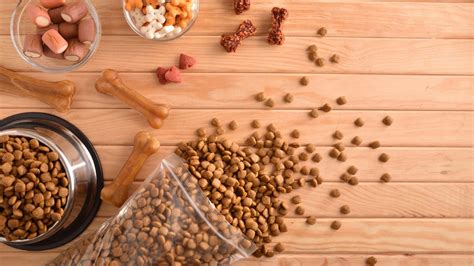Maintaining optimal health and vitality for your beloved pets involves providing a balanced and nutritious diet. However, navigating the vast array of pet food options and understanding proper feeding practices can be a daunting task. This comprehensive guide aims to empower you with the knowledge and resources you need to make informed decisions about your pet’s nutrition and ensure their well-being.

Pet Nutrition: The Basics
Types of Pet Food:
- Dry food: Convenient, shelf-stable, and often contains essential nutrients.
- Wet food: High in moisture, palatable, and provides adequate nutrition.
- Raw food: Uncooked, whole ingredients that mimic a natural diet but require careful preparation and storage.
Nutritional Requirements:
- Protein: Essential for building and repairing tissues, and sources include meat, poultry, and fish.
- Carbohydrates: Provide energy and fiber for digestive health, and sources include grains, fruits, and vegetables.
- Fats: Essential for energy, skin health, and hormone production, and sources include animal fats and plant-based oils.
Pet Education Resources
Online Resources:
- PetMD: Comprehensive pet health information, including nutrition articles and expert advice.
- The Spruce Pets: Trusted source for pet care tips, product reviews, and breed information.
- WebMD Pets: Up-to-date pet health and nutrition news, and a directory of veterinarians.
Books:
- Small Animal Clinical Nutrition (5th Edition): Textbook for veterinarians and pet nutritionists.
- The Complete Guide to Pet Nutrition: Choosing and Feeding Your Dog and Cat for a Long, Healthy Life: Practical guide for pet owners.
- Feeding Dogs and Cats for Dummies: Easy-to-understand resource for feeding your pets correctly.
Veterinarians:
- Consult with your veterinarian: Seek professional guidance on your pet’s specific nutritional needs and health conditions.
- Board-certified veterinary nutritionists: Specialists in pet nutrition who can provide tailored dietary recommendations.
Free-Range Feeding: Benefits and Concerns
Benefits:
- Natural diet: Allows pets to select a variety of natural foods, including insects, plants, and prey.
- Exercise and mental stimulation: Encourages pets to forage and explore their environment.
- Reduced boredom: Can help prevent destructive behaviors associated with confinement.
Concerns:
- Nutritional imbalances: Pets may not consume a balanced diet, leading to deficiencies or excesses.
- Parasites and diseases: Raw foods can harbor harmful parasites or bacteria.
- Environmental hazards: Pets may ingest toxic substances or plants.
Comparison of Pet Nutrition Approaches
| Characteristic | Traditional Pet Food | Free-Range Feeding |
|---|---|---|
| Convenience | High | Low |
| Nutritional balance | Guaranteed | Variable |
| Safety | Controlled | Dependent on environment |
| Cost | Moderate to high | Potentially lower |
| Veterinary support | Available | Limited |
Effective Strategies for Pet Nutrition
- Match the diet to your pet’s age, activity level, and health status.
- Choose high-quality pet foods that meet AAFCO standards.
- Read ingredient lists carefully and avoid questionable ingredients.
- Feed your pet regular meals, twice or three times a day.
- Monitor your pet’s weight and body condition.
- Provide fresh water at all times.
- Avoid human food scraps and treats that are harmful to pets.
Tips and Tricks for Pet Nutrition Success
- Rotate pet food flavors to prevent boredom.
- Offer a variety of treats, such as fruits, vegetables, or low-sodium jerky.
- Use food puzzles to slow down your pet’s eating and prevent obesity.
- Measure your pet’s food portions to avoid overfeeding.
- Consider homemade pet food diets under the guidance of a veterinarian or pet nutritionist.
Common Mistakes to Avoid
- Overfeeding your pet: Can lead to obesity, diabetes, and other health problems.
- Feeding your pet human food scraps: Can be harmful or even toxic.
- Not addressing your pet’s specific nutritional needs: Different pets have different dietary requirements.
- Switching pet food brands too often: Can cause digestive upset.
- Ignoring your pet’s food allergies: Can lead to skin problems, digestive issues, or respiratory distress.
Reviews of Pet Nutrition Resources
- PetMD: Highly reputable source with a vast library of pet health information.
- The Spruce Pets: Well-written articles and product reviews, but may not be as comprehensive as other resources.
- WebMD Pets: User-friendly website with helpful pet health tools and a symptom checker.
- Small Animal Clinical Nutrition (5th Edition): Comprehensive textbook for professionals, but may be too technical for general readers.
Highlights and How to Stand Out
- Highlight your pet’s unique nutritional needs and health status.
- Emphasize the importance of consulting with a veterinarian for personalized advice.
- Offer a diverse range of resources, including online articles, books, and videos.
- Provide interactive tools, such as diet calculators and meal planners.
- Partner with veterinarians and pet nutrition experts to enhance credibility.





















